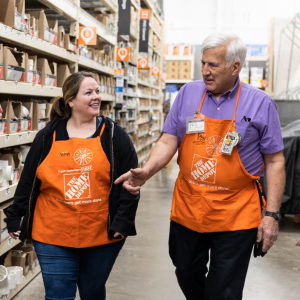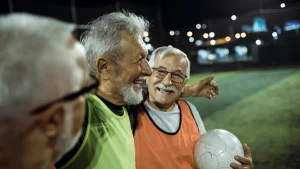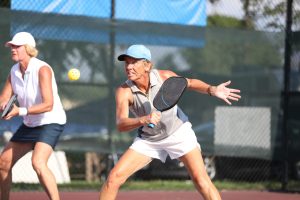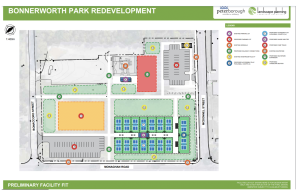6
Section One: The Fundamentals
A) Keywords
Exercise 1:
Provide a brief definition of one of the padlet keywords for this week.
|
Social gerontologists Social gerontologists are individuals who specialize in the study of social aspects of aging. These professionals identify that while ageing is inevitable and irreversible, there is a large social significance that accompanies the understanding of ageing. Social gerontologists have also identified how engagement in activities such as sports as we age carries a significant meaning. Among studying the impacts of sports and physical activity on the ageing body, these professionals also focus on other attributes that affect an ageing adult life, such as relationships, policy influence, and other external societal factors.
|
B) The Social Significance of Aging in Sport
Exercise 2: Notebook Prompt
How is old age popularly represented today? Find an image online that you think exemplifies one defining attitude towards old age and paste in your notebook below with a brief explanation of what this image means to you.

I believe the representation of old age today has drastically changed to represent a diverse, independent, and active group of individuals. Despite their age, many elderly people continue to be integral members of society and contribute to their communities just as much as their younger counterparts. While this could be attributed to the economy and other external factors such as the desire to remain active and purposeful, we see more elders today participating in the everyday workforce and continuing to be active members of society despite their ability to retire and refrain from contributions. Compared to decades ago, when once the age of retirement was reached, elders would stop working and fulfill their lives as retirees, we see less of that today. Instead, the notion of reaching such age and disappearing from society to live life as a retiree could now be considered stereotypical for ageing and elderly individuals. This new perception highlights the benefits to both society and to ageing people when they remain active within their personal lives, but also in society and within their communities.
|
Exercise 3: Notebook Prompt
What does the article (referencing another study by Dionigi) mean by its statement that sport can help aging people to simultaneously “accept and resist the ageing process” (572)? Respond by audio or text and find paste two images sourced online into your notebook showing how sport might help aging people to both accept and resist the aging process.
 
I interpret the statement that sports can help aging people simultaneously ‘accept and resist the aging process’ as highlighting the way sports can assist individuals in celebrating and empowering them through the aging process. The ability for these individuals to participate in sports that are less competitive and more diverse, or even completely remote through VR or video games, allows for individuals to maintain a level of physical activity that may otherwise diminish with their age. This would likely assist in accepting the aging process by showing these individuals that their bodies are still capable despite their age, and push against the dominant perception that sports and certain activities are not for aging bodies- providing empowerment and a sense of control over aging. This empowerment and control can also aid in the feeling of resisting aging. Additionally, because participation in sports can make older individuals appear younger and meet social expectations, simple participation in a sports activity can provide the feeling that they are resisting aging through the appearance of youthfulness. Sports offer these individuals an option of autonomy and control over their bodies that validates and encourages the feeling of vitality, health, and youthfulness. Through sports and physical activity, they can resist aging and empower themselves, without negating the fact that aging is inevitable, but ensuring that they do so in a healthy way. |
Exercise 4: Notebook Prompt
Who are the groups less likely to have extensive opportunities to take part in sports, according to Pike? How does privilege factor into aging and sport? (200 words max)
|
According to Pike, those less likely to have extensive opportunities to take part in sports are those with disabilities, the very frail, some minority ethnic groups, those confined to care facilities, and those living in rural areas. Those who are considered to be ‘privileged’ may have easier access to modified sports or activities to better suit their disability or frailness. This privilege may also apply to having the ability to choose sports teams that are more inclusive or have more members of their ethnicity. Finally, privilege can allow for these individuals to select care homes that provide increased opportunities for access and participation in sports, or the ability to participate in sports that are farther away (if living in rural areas) by being able to transport themselves or having the luxury to arrange transportation by someone else. Much of this privilege comes from financial freedom and family support, which not all aging individuals have.
|
Exercise 5: Padlet Discussion
Why do you think age discrimination is “reported more than any form of prejudice” with older people presented as a threat to social values and interests? Feel welcome to use video in your responses. Paste your comments (or transcript of your video) below!
|
I believe age discrimination is so frequently reported because of the way our society is structured. With a strong emphasis on economic productivity and societal contribution, and especially since COVID-19, a heightened focus on health and well-being, older individuals are often perceived as less valuable than their younger, working counterparts. Stereotypes that depict elderly people as frail, meek, or no longer useful within the economy and society reinforce the idea that they are a burden rather than a benefit to society. This furthers the idea that they are seen as a threat to social values and interests. What we often neglect to remember with these stereotypes is that aging is something inevitable and a factor that each human, no matter their age now, is subject to. Because discrimination against age is so normalized and could even be considered a ‘universal’ form of prejudice, it goes unchallenged and remains an issue that is constantly reported, yet little is done to solve the issue.
|
B) Older Women and Sport
Exercise 6: Notebook Prompt
What differences do you see in these ads? Which one is more inclusive? How is age represented or not represented in each? Answer these questions in your notebook.
|
The first noticeable difference between the two videos is the ages of the athletes captured in each. The first video, focusing on younger athletes, emphasizes the strength and empowerment that goes into competing in their sport. However, the second video showcases more training than competing to highlight that at an older age, you must work harder to be able to play sports. It also depicts multiple times switching from training or playing a sport to fulfilling mothering duties- sending an underlying message that older women must put their sports and physical activity on hold to fulfill their duties as mothers first. Neither video is inclusive of age, one focuses solely on younger athletes and high-level competing, while the other focuses on older athletes with lower-level competition and outside duties (such as motherhood) that the athletes in the first video were not subject to. Overall, age is represented as a determining factor in sports competition and is shown as a barrier to competition. The first video does not accurately reflect the fact that many young athletes of high-level competitive sports have children and balance their active lifestyle and competition with motherhood. Likewise, the second video does not depict the fact that many levels of an older age do not have children (through choice or personal factors) and instead have chosen to focus on their sport and have and continue to compete in high levels of such. |
Exercise 7: Notebook Prompt
In her article, “Assessing the sociology of sport: On age and ability,” Elizabeth Pike references a “trend towards a ‘feminisation of ageing’, with many women living longer than men” (573). Do you agree that aging has been “feminized” in this way? How? Answer these questions in your notebook.
|
I agree that in this specific way, aging has been feminized. Though statistics show that women live longer than men, stereotypically, these same women are neglected in conversations surrounding aging, particularly around aging individuals who participate in health, wellness, and athletics. As women are expected to be caretakers rather than athletes, men are granted the ability to be athletic, strong, and fit throughout their journey of aging. This conforms women to feminist stereotypes and highlights gender expectations that follow women through all of life and well into their elder years. Aging women are expected to adhere to these stereotypes rather than prioritize their physical and mental well-being through sports and physical activity.
|
Section Three: Module Mini Assignment

As I understand it, the largest debates surrounding the building of the pickleball courts and demolition of Bonnerwoth Park are regarding the disastrous impact it will have on the environment, the loss of space for children and adult recreational sports, and the space being turned into an area that will predominantly serve connoisseurs of pickleball. With the majority of the space currently serving as a greenspace, the environmental benefits it serves are large. Not only does the abundant greenspace provide a natural cooling effect, it also aids in protecting against flooding, among many other benefits. In addition to the grassy space, Bonnerworth has two large ball diamonds that often house children’s baseball games for the Peterborough Baseball Association, which is also the governing body for the Peterborough Tigers- the city’s most prominent baseball team. On top of all of this, the park also includes tennis courts and a skatepark and serves a wide variety of residents with varying interests in sports and leisure activities. However, the new model of the park is specifically designed to predominantly cater to pickleball players, though this sport can easily be played on the existing tennis courts. The older athletes and advocates that pickleball is commonly known to cater to are represented in the media and surrounding this issue, being granted a massive reward for a ‘fad sport’. Many feel that the creation of a new park that revolves around pickleball is unnecessary and that athletes could have made do with the existing tennis courts around this city, as many of them just recently were upgraded or redone. The neoliberal agenda, as Pike mentioned, highlights how older people should use their time productively and engage in anti-aging activities to reduce the impact of aging, which is exactly what pickleball provides its older athletes. Yet the majority of residents feel that these individuals are unworthy of adequate space to play their sport. Recently, a portion of free space on Lansdowne Street was turned into a new arena, the Miskin Law Complex, where hockey and lacrosse for children and younger generations would be catered to. During the initial construction, discussion, and opening of this arena, there was no backlash. I believe this highlights a high level of ageism toward the transformation of Bonnerwoth and the older players of pickleball. I feel that if Bonnerwoth was transformed into a space that catered to a younger generation, there would be far less if any, backlash. The scrutiny the park received and the lack of such for arena highlights how despite neoliberal views encouraging elders to take care of themselves, when they do so and are granted the opportunity to have a space to regularly participate in sports, they are criticized for trying.
sites used: https://journals-sagepub-com.proxy1.lib.trentu.ca/doi/full/10.1177/1012690214550009 https://savebonnerworthpark.ptbo.org/
|

